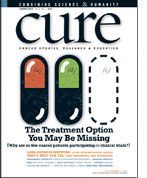Mixing It Up
Food-drug interactions can adversely affect cancer treatment.
As if being treated for cancer weren’t difficult enough, patients must also be keenly aware of the risks posed by unexpected food-drug interactions. Unfortunately, experts warn, it’s a topic many cancer patients know nothing about.
“The issue of food-drug interactions is seldom on a patient’s radar because of so many things going on, whether it’s emotional issues, changing schedules, or simply dealing with the burden of treatment,” observes D. Milton Stokes, RD, a registered dietitian in Stamford, Connecticut, who works with cancer patients. “If a physician, nurse, or pharmacist doesn’t bring it up, often the patient has no idea.”
This can be potentially devastating because the effects of many cancer drugs are easily influenced by commonly consumed foods, beverages, or dietary supplements, reports Mark Ratain, MD, associate director for clinical sciences at the University of Chicago Comprehensive Cancer Center. Cancer drugs, compared with other drugs, have a narrower range over which effectiveness and side effects will fluctuate with just small variations in the drug level or bioactivity.
For example, high-fat meals and grapefruit juice can influence how much of the breast cancer drug Tykerb (lapatinib) is absorbed in the body. Plus, the prescribing directions for Tasigna (nilotinib), which treats chronic myeloid leukemia, warn that the drug should never be taken with food because it can dangerously increase levels of the drug in the body. To be safe, Tasigna should be taken at least two hours after consuming any food, and another hour should pass after taking the drug before eating.
According to Ratain, there are several ways a food or beverage can affect a medication. This may include inhibition or induction of metabolism, as well as effects on absorption, potentially resulting in very significant increases or decreases in the drug concentration.
“All are areas of concern for patients on any drugs we would consider narrow therapeutic index [any drug which has a less than twofold difference between the minimum toxic concentration and minimum effective concentration in the blood],” Ratain says. “And I would say the vast majority of oncology drugs would be considered narrow therapeutic index.”
“The issue of food-drug interactions is seldom on a patient’s radar because of so many things going on.”
Another area of drug interaction often overlooked by patients and physicians is over-the-counter dietary supplements. “I believe that anyone who is taking supplements with their anticancer therapy is playing with fire,” states Ratain.
Ratain’s concern is well founded. Supplements, commonly consumed for everything from mild depression (St. John’s wort) to cold relief (echinacea or chamomile tea), are known to influence the action of certain medications.
“Patients take supplements because they are advertised as natural, and natural is synonymous with safe and healthy,” says Stokes. “I remind them that tobacco and the sun are both natural, and both are cancer-causing agents. So just because something is natural doesn’t necessarily indicate safety.”
What can you do to prevent potentially dangerous food-drug interactions? Foremost, says Ratain, read and follow all drug labels carefully. And don’t hesitate to raise the issue of food-drug interactions with your physician, or ask your pharmacist when you get a prescription filled.
Stokes agrees. “Sometimes providers won’t know the answer, but they will be able to find it somewhere,” he says. “I tell my patients to be the squeaky wheel.”
For additional information about food-drug interactions, visit the American Dietetic Association (www.eatright.org) or the National Cancer Institute (www.cancer.gov).
